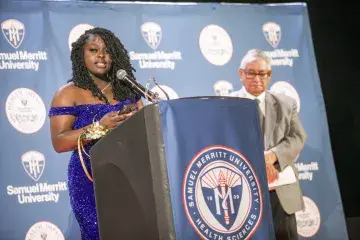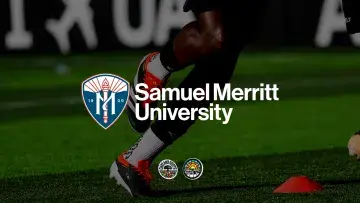What Does Movement Have to Do with Occupational Therapy? Everything.
Student Voices is a blog series written by SMU students. If you have an idea for a story, reach out to ssolo@samuelmerritt.edu. This article is written by occupational therapy student Tamara Sanchez Monter.
“Everyone get in a circle and let’s begin our warm-up,” my dance instructor says as people start shuffling in. I look around the room and see some people grab onto others’ arms, some people place their hand on the wall, and some lean forward to remain balanced for 10 seconds.
When dancing a polka, we need to constantly keep our balance because it requires rapid footwork and it incorporates a lot of quick spins and staccato movements. When dancing the Mexican folk dance huapango, the movement tends to be smoother but requires weight shifting because there is more footwork involved.
Every single person in my dance group has different abilities and strengths and because of that our instructor makes sure to challenge us every day to develop the necessary skills to learn new dances. Movement is an integral part of dancing, and my love for movement has kept me returning to this class for three years.
My love for movement in part brought me to the occupational therapy field. While it’s commonly understood that movement is critical to physical therapy, it’s less widely known that occupational therapists (OT) empower people through a holistic, mind-body approach. OTs work with individuals to engage and participate in occupations that are meaningful to them, whether it be cooking, rock climbing, hiking, painting, scuba diving, or dancing. Everything we do in our daily lives involves and requires movement, which is why OTs incorporate movement in therapy.
When working with pediatric clients we may focus on fine motor skills necessary for handwriting, or on gross motor skills essential to playing soccer and climbing on a play structure. For people with spinal cord injuries, one of our roles is to prevent clients from developing pressure sores and we do this through bed mobility as well as transfers into and out of their wheelchairs. We may work with older adults on balance and walking post-stroke, or promote social participation through chair movement exercises, skee-ball, or dancing activities.
At SMU, I have learned so much more about occupational therapy and the people we get to interact with in our clinical rotations. Our clients range from babies to older adults with a variety of diagnoses that may include physical or mental limitations, so it is important to address the person as a whole.
For the past three years, dancing has become one of the most important self-care occupations I engage in and I have realized as an OT student that identifying which activities are special to my clients can help guide their therapeutic process. Movement through occupations is a powerful therapeutic tool.


